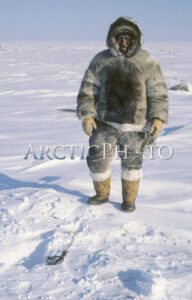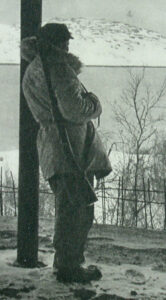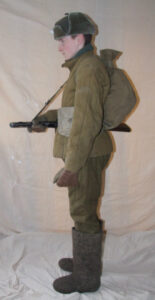Today I am going to continue on the previous topic of cold weather clothing, with an emphasis on footwear.
Once again, we will start by looking at the Inuit solution to keeping your feet warm while the snow is on the ground.
Mukluks or kamik are constructed in the same way as the clothing already discussed. Two layers of fur, the inner with the fur facing inwards and the outer with the fur outwards. Interestingly mukluks are sometimes used with a sealskin moccasin that fits over the outside and provides extra insulation and reduces wear on the mukluk.


The Russian solution to snow on the ground is the valenki.
Valenki are  similar to the mukluk in principle, but made from thick felt rather than a double layer of fur.
similar to the mukluk in principle, but made from thick felt rather than a double layer of fur.
 similar to the mukluk in principle, but made from thick felt rather than a double layer of fur.
similar to the mukluk in principle, but made from thick felt rather than a double layer of fur. Like the mukluk, they trap a layer of warm air while allowing the free passage of perspiration.
I have heard that valenki are quite good for when the snow is deep and temperatures low but not so good when the coverage of snow is less even or when temperatures are warm enough for snow to get slushy.
Not surprisingly, a nuseful addition to valenki are galoshes. These add a sole that provides grip and prevent water soaking into the valenki.
Galoshes are of course impermeable but I suspect this is not usually a problem since the rest of the valenki is exposed to the air. Perspiration that accumulates within the galosh is soaked up by the felt and wicks up to the higher parts of the valenki where it can escape.
Famously, Russian soldiers order their winter boots a size larger than their summer boots so they can wear more insulation within them.
I don’t know if this is applicable to valenki too but this does bring us to the interesting topic of what is worn within boots.
Up until about 2008, Russian soldiers wore foot wrappings (portyanki). Foot wrappings were once the norm for footwear in Europe, socks being more labour intensive to make and expensive. The use of foot wrappings persisted longer in military circles, surviving into the 21st century in the Russian army.
This site nicely sums up the merits of foot wraps.
“There are some advantages to wearing foot wraps as opposed to socks. Portyanki better support the foot and air trapped in the folds better insulate the foot. Also, when wet they can be dried quicker than traditional socks. Wrapping the portyanki is a difficult technique to perfect and getting it wrong can cause some discomfort. However, once perfected, they are extremely comfortable to wear and obviate the need to perhaps wear several pairs of socks with sapogi boots.”
Apparently Russian soldiers would wear their portyanki for a week at a time, exchanging them for fresh ones when they took their weekly shower. The old ones were boiled.
Not surprisingly, many soldiers joked that that portyanki were the true chemical weapons.
I don’t intend to abandon my socks, but foot wraps are a useful idea to know about if need to improvise footwear or provide extra insulation to go over your socks.











